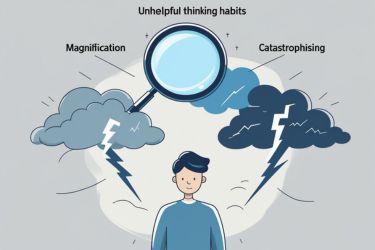Unhelpful thinking habits can significantly affect our mental health. One common habit is personalization, where we wrongly assume that we are at fault for events beyond our control. By recognising this thinking style, we can begin to challenge our beliefs and reduce unnecessary stress.

Understanding how personalization works helps us see situations more clearly. It allows us to realise that we are not always to blame for negative outcomes. This clarity can lead to better decision-making and improved emotional well-being.
Taking steps to address personalization can be liberating. When we learn to challenge these thoughts, we open ourselves up to healthier thinking patterns that enhance our lives. Let's explore how we can identify and overcome this unhelpful habit together.
Key Takeaways
- Personalization can distort our view of reality and negatively impact our mental health.
- Recognising and challenging this habit is vital for emotional well-being.
- Adopting new strategies can lead to lasting improvements in how we think and feel.
Understanding Personalisation as an Unhelpful Thinking Habit

Personalisation is a common form of cognitive distortion where individuals incorrectly believe they are to blame for events outside their control. This thinking style can lead to increased feelings of guilt and anxiety, which affects mental health. We will explore its definition, how it develops, and how it differs from other cognitive distortions.
Definition of Personalisation
Personalisation is when we attribute personal responsibility for negative events, even when we have no direct role. For example, if a friend is upset, we might think it is our fault, even if there are many reasons for their feelings. This habit is unhelpful because it leads to unnecessary guilt.
People employing personalisation often engage in negative thought patterns. Such automatic thoughts can trigger feelings of sadness and worry. Recognising this pattern can help us understand the impact of our thinking on our emotions.
How Personalisation Develops
Personalisation often stems from past experiences, including childhood interactions and coping mechanisms. When we grow up in environments where we are blamed for problems, we start to internalise those messages. As a result, we may develop this unhelpful thinking style as an automatic response to stress.
Our brains seek to make sense of events. When we cannot find a clear reason for something negative, it is natural to look for a cause. This leads us to blame ourselves, even when it is unfounded. Over time, this habit can become ingrained, reinforcing our negative thoughts.
Differences Between Personalisation and Other Cognitive Distortions
Personalisation differs from other cognitive distortions in its focus. While many cognitive distortions involve exaggeration or unrealistic thinking, personalisation specifically entails self-blame for external events.
For example, in "all-or-nothing" thinking, we may see situations in black-and-white terms. Meanwhile, personalisation makes us feel responsible for the grey areas. We must distinguish personalisation from other thought patterns to better address our mental health.
Recognising these differences empowers us to challenge our thinking styles. Therapy and mindfulness are effective tools that can help us break free from this cycle of blame and develop healthier perspectives.
Impact of Personalisation on Mental Health

Personalisation can significantly affect mental health, often leading to increased emotional distress and poor self-esteem. We can see how it links closely to anxiety and depression, impacting our overall wellbeing in various ways.
Emotional and Psychological Effects
When we personalise, we take on unnecessary blame for negative events. This shift in thinking can lead to feelings of guilt and shame, which are harmful emotions. We may start to believe that everything is our fault, even when it is not the case. This creates a cycle of negative thinking.
As our thoughts spiral, we can develop heightened anxiety. We may worry excessively about how our actions affect others. Constantly second-guessing ourselves also breeds feelings of inadequacy. This emotional turmoil takes a toll on our mental health and can lead to significant distress.
Personalisation in Anxiety and Depression
Personalisation is closely linked to anxiety and depression. Individuals who personalise often feel overwhelmed by guilt, contributing to anxiety disorders. For example, we might think, “If I fail, it’s because I am not good enough,” leading to excessive worrying about performance.
In those experiencing depression, these thoughts can become all-consuming. We may feel a strong sense of hopelessness and view ourselves negatively. According to studies, individuals who engage in personalisation are more likely to face severe depressive symptoms. Understanding this connection is vital for improving our mental health.
Influence on Self-Esteem and Wellbeing
Low self-esteem often goes hand-in-hand with personalisation. When we blame ourselves for various outcomes, our self-worth diminishes. The constant cycle of negative self-talk makes it hard to build a positive self-image.
This effect doesn't just stay personal; it also impacts our relationships. As we feel less confident, we may withdraw from social interactions. This can lead to isolation, further affecting our sense of wellbeing. By recognising the influence of personalisation, we can take steps to change our thinking patterns and improve our mental health.
Common Patterns and Examples of Personalisation

We often see personalisation manifest in our thoughts and behaviours. This habitual way of thinking can lead to significant misunderstandings about our role in various situations. Let us explore common patterns, examples, and how they relate to other negative thinking habits.
Everyday Situations Involving Personalisation
Personalisation frequently occurs in daily life. For example, we may wrongly believe that if a friend is upset, it’s our fault, even if the issue has nothing to do with us. This pattern of thought can lead to feelings of guilt and anxiety.
Another common situation is in the workplace. If we receive critical feedback, we might think, “I must be terrible at my job,” ignoring constructive aspects of the comments. This leads to overgeneralisation, where a single event shapes our view of ourselves.
In relationships, we might think, “My partner forgot my birthday; they must not care about me.” This jump to conclusions ignores other possible explanations, like stress or forgetfulness.
Links with Other Negative Thinking Habits
Personalisation is often linked with several other negative thinking habits. For instance, we might engage in catastrophising when we believe one mistake reflects our entire character. This creates an exaggerated fear of failure.
We often see mind reading involved here. We assume we know what others think about us based on our actions. This assumption can create unnecessary stress and tension in relationships.
Black-and-white thinking can also play a role. We may see situations as all good or all bad, failing to recognise the grey areas. This can exacerbate our tendency to personalisation, leading us to feel like failures when something doesn’t go perfectly.
Identifying Automatic Negative Thoughts
To tackle personalisation, we must identify our automatic negative thoughts, often referred to as ANTs. These can include self-critical thoughts like “I always mess things up” or “People dislike me.”
Recognising these thoughts is the first step in addressing them. We should ask ourselves whether these thoughts are true or if we are being unfairly harsh.
Using a thought diary can help track patterns. We can note situations that trigger personalisation and identify the associated thoughts. By challenging these thoughts, we can reduce their power over our feelings and behaviours.
Recognising and Challenging Personalisation

To manage personalisation, we need to focus on building self-awareness and identifying our triggers. By understanding the patterns of our thoughts, we can begin to challenge these negative automatic thoughts effectively.
Building Self-Awareness
Self-awareness is crucial for recognising when we are personalising situations. It involves reflecting on our thoughts and feelings. We can ask ourselves questions like, “Why do I feel responsible for this?” or “Is this true?”
Journaling can be an effective tool. Writing down our thoughts helps in spotting recurring themes. We can track moments when we blame ourselves for things out of our control. This practice allows us to view our thoughts more objectively.
We should also pay attention to our emotional responses. Feelings of guilt, shame, or anxiety often point to personalisation. Acknowledging these feelings helps us understand our interpretations and begin to challenge them.
Spotting Triggers and Patterns
Identifying triggers is essential in breaking the cycle of personalisation. Triggers can be specific situations, people, or even certain phrases that lead to negative thoughts.
We can make a list of these triggers. This can help us notice patterns in our thinking. Once we identify our triggers, we can prepare ourselves to handle them better.
It’s helpful to practise positive self-talk when we encounter these situations. Instead of assuming blame, we can remind ourselves that not everything is within our control. We can replace negative thoughts with more balanced ones.
Through consistent reflection and awareness, we can challenge harmful thought patterns. This process takes time, but it is a powerful step towards healthier thinking.
Strategies for Overcoming Personalisation
To combat the effects of personalisation, we can adopt several effective strategies. By incorporating cognitive behavioural therapy (CBT) techniques, mindfulness practices, and positive thinking approaches, we can shift our thought patterns and build resilience against negative thinking.
Cognitive Behavioural Therapy Techniques
CBT provides practical tools to help us identify and challenge our negative thoughts. One useful technique is to keep a thought diary. In this diary, we can record instances when we feel responsible for events outside our control.
Once we note these thoughts, we can evaluate their validity. For example, asking ourselves questions like, "Is there evidence supporting this thought?" helps us reconsider our assumptions.
Additionally, we can practice behavioural experiments. We can expose ourselves to situations we often avoid due to our personalisation tendencies and assess the outcomes. This exposure therapy reduces anxiety and allows us to see that we are not to blame for every negative outcome.
Cognitive Restructuring and Reframing
Cognitive restructuring and reframing are techniques aimed at changing how we perceive our thoughts. When we notice that we are personalising events, we can actively reframe our thoughts.
For instance, instead of thinking, "If I had done better, this would not have happened," we might reframe it to, "There were many factors at play in this situation." This change in perspective helps us acknowledge that not everything is our fault.
By doing this consistently, we train our minds to adopt a healthier outlook. Practising these skills allows us to detach from the need to take responsibility for external events.
Building a Positive Mindset
Developing a positive mindset is crucial in overcoming personalisation. We can start by practising self-compassion. When we make mistakes, it is important to treat ourselves kindly rather than harshly.
We can also engage in positive self-talk. This involves replacing negative statements about ourselves with affirming ones. For example, switching, "I always mess things up," to "I can learn from my mistakes," helps us foster resilience.
Additionally, we can focus on our strengths and achievements. Making a list of our accomplishments reinforces our sense of self-worth and reminds us that we are more than our mistakes.
The Role of Mindfulness and Journaling
Mindfulness helps us become aware of our thoughts without judgement. By practising mindfulness, we can observe our feelings of personalisation as they arise. This distance allows us to respond thoughtfully instead of reacting automatically.
Journaling can complement mindfulness by providing an outlet for our thoughts and feelings. Writing down stressful experiences allows us to process and analyse our emotions. We can reflect on whether our feelings of responsibility are justified.
Through these practices, we create space for self-reflection and growth. This blend of mindfulness and journaling helps us tackle unhelpful thinking habits and reduce personalisation over time.
Long-Term Benefits of Addressing Personalisation
Addressing personalisation can lead to significant improvements in mental health and overall quality of life. We will explore how it enhances our relationships, builds mental resilience, and helps prevent a return to unhelpful thinking patterns. Each of these areas plays a crucial role in our emotional well-being.
Improving Mental Health Resilience
When we understand personalisation, we can develop greater mental health resilience. This means we become better at handling stress and adverse situations. We learn to separate our self-worth from external outcomes.
As we challenge these thought patterns, we often find it easier to manage anxiety and depression. For example, we might practice cognitive restructuring techniques. This approach helps us recognise and reframe negative thoughts, reducing their power over us. Over time, our reactions to stress can improve.
Enhancing Relationships and Communication
Addressing personalisation can greatly enhance our relationships and communication skills. We often blame ourselves for issues that arise in our interactions. By recognising that not everything relates back to us, we can communicate more effectively.
This shift allows us to take responsibility without undue self-blame. As we become more open to discussing our feelings, our relationships tend to deepen. Improved communication helps us resolve conflicts without falling into patterns of guilt or shame, fostering healthier connections with others.
Preventing Relapse into Unhelpful Thinking
An important benefit of addressing personalisation is the prevention of relapse into unhelpful thinking. Once we understand this cognitive distortion, we can actively work to avoid it in the future. We can recognise triggers and implement strategies to manage our thoughts.
By using therapeutic approaches, such as mindfulness and cognitive behavioural therapy, we can build strategies that help us stay grounded. Regularly practising these skills allows us to maintain our mental health. As we grow more aware of our thinking habits, we create a buffer against negative thoughts returning.
Frequently Asked Questions
In this section, we will explore common inquiries about personalization as an unhelpful thinking habit. We will define what it is, how to identify it, and provide examples. Additionally, we will discuss its impact on mental health and relationships and offer strategies to challenge this habit within therapy.
What constitutes personalization in the context of cognitive behavioural therapy?
Personalization is when we take undue responsibility for events that are not our fault. This thinking pattern leads us to believe that we are to blame for negative outcomes. It distorts our perception, making us think our actions directly affect unrelated situations.
How can one identify personalization as an unhelpful thinking habit?
We can recognise personalization by being aware of our self-talk. If we often find ourselves saying things like "It's my fault" or "I should have done something," we may be personalising situations. Keeping a journal of thoughts and feelings can help us spot these patterns over time.
What are typical examples of personalization that individuals may experience?
An example of personalization is feeling responsible for a friend's bad mood, believing it stems from something we did or said. Another instance may involve feeling guilty about a work error that resulted from team decisions. These examples highlight how we attribute blame to ourselves incorrectly.
How does personalization differ from other unhelpful thinking styles?
Personalization is distinct because it focuses on taking excessive blame for events. Other unhelpful thinking styles, such as catastrophising or black-and-white thinking, involve different thought distortions. While those styles might exaggerate outcomes or see issues in extremes, personalization narrows the focus to self-blame.
In what ways can personalization impact one's mental health and relationships?
Personalization can lead to feelings of guilt, anxiety, and low self-esteem. It can create unnecessary pressure on ourselves and strain relationships, as we may over-apologise or withdraw. This habit can make us feel isolated and misunderstood by others.
What strategies are effective in challenging personalization within therapeutic settings?
Cognitive behavioural therapy often uses techniques such as reframing thoughts and examining evidence. We can challenge our beliefs by questioning the validity of our self-blame. Practising self-compassion and focusing on external factors can also help us reduce the impact of personalization on our lives.




















